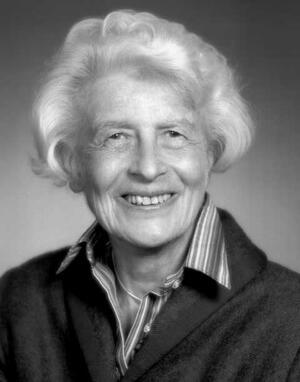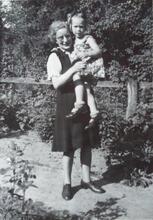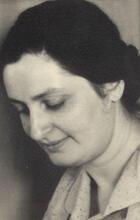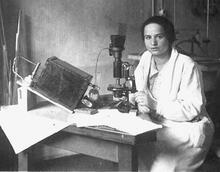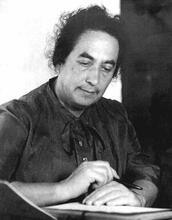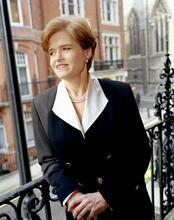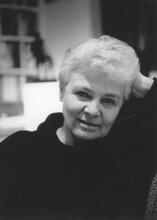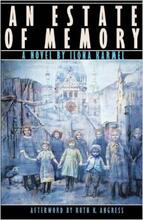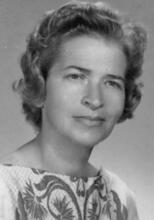Gertrude Scharff Goldhaber
Throughout a career limited by her gender, her religion, and her marital status, physicist Gertrude Scharff Goldhaber helped ensure other women scientists would not face the same hurdles. She married Maurice Goldhaber in 1939 and immigrated from Germany to the United States, where he taught at the University of Illinois, Urbana. There, barred from a university position by nepotism rules, she worked instead as her husband’s unpaid assistant. In 1972 she was elected to the National Academy of Sciences and served on their Committee on the Status of Women in Physics, pushing to end artificial barriers for women in the sciences. Forced to retire at age 66, Goldhaber continued to collaborate with other scientists whenever possible.
Background and Early Life
“The vicious cycle which was originally created by the overt exclusion of women from mathematics and science must be broken… [I]t is of the utmost importance to give a girl at a very early age the conviction that girls are capable of becoming scientists.” Gertrude Scharff Goldhaber
Throughout her life Gertrude Scharff Goldhaber had to struggle against tyranny and discrimination, as a child during World War I, as a Jew in Nazi Germany, as a woman in a scientific discipline when there were few such practitioners, and as the wife of another scientist at a time of strict nepotism rules. That she was so successful is a testament to her talent, drive, and will.
Trude, as she was called by her friends, was above all a dedicated physicist. She was often passing on news about a recent advance, whether hers or others. Despite all the hardships she endured, she was predictably cheerful. Probably, her happy marriage and family life helped her achieve an ever-cheerful disposition.
Gertrude Scharff was born in Mannheim, Germany, on July 14, 1911, just a short time before the relative serenity of the previous century was shattered by the outbreak of World War I. Many people know about the battlefield horrors of that war, but even well behind the lines things were tough. Trude recalled bread made partly of sawdust—good roughage but not very nutritious.
Scharff attended public school in Mannheim, where she developed an interest in science, with the support of her parents (surprising for that time), perhaps because her father had to abandon a plan to go into chemistry at the age of sixteen when his father died and it became necessary to work in the family’s food wholesaling business. Even with the end of the war, life in Germany was difficult, with hyperinflation in the mid-1920s, followed by worldwide depression. Nevertheless, Scharff went on with her studies, entering the University of Munich and fairly soon coming to focus on physics. Although her father preferred that she be a lawyer, she recalled saying, “I’m not interested in the law. I want to understand what the world is made of.”
A frequent pattern in those days was for students to spend semesters at various universities, and she did that three times, visiting Freiburg, Zurich, and Berlin before settling down to thesis research with Walther Gerlach at Munich. In Berlin she first met her future husband. We are unaware of any local female mentors or role models, but she had good relations with her professors.
A major problem arose with the accession of the Nazis to power in 1933. It became increasingly difficult for Jews working at a university or running a business to continue to do so, and next to impossible for one to find a position. Her father was jailed, and after release went with her mother for a short stay in Switzerland. After returning, they never succeeded in leaving Germany again; both perished in the Holocaust.
Moving Around
Meanwhile, she attained her PhD in 1935; as work in Germany was impossible, she headed for London. Her younger sister Liselotte had already left Germany. Scharff stated “I should have left earlier, but since I had started my thesis I felt I should finish.” Having a PhD degree actually was a disadvantage, as there was more room for refugee students than refugee professionals. For six months Scharff lived from the proceeds of selling a Leica camera and translating German manuscripts into English. Eventually she got a job in a lab run by G. P. Thomson, but she never obtained a real position. In 1939, prior to the beginning of World War II, she and Maurice Goldhaber married, and she moved to join him at the University of Illinois in Urbana.
An issue of women in science then came to the fore. Maurice already was on the faculty at Illinois, and so, according to strict interpretations of state anti-nepotism laws, she could not be hired as well. Beyond that she was not even allowed lab space, so her only options were to quit research or to accept her husband’s invitation to join him in his lab, with no salary, of course. With her drive, there was no real choice. Not only was she unpaid, which meant that Maurice’s salary had to cover all costs, including in due course child care for their two sons Alfred and Michael, but also she had to switch fields to make use of the resources in the lab, which was devoted to nuclear physics. Obviously, she made the transition with considerable flair.
Finally, some time after the war, she was placed on a soft-money line in the Physics Department at Illinois. We have heard that women in the faculty there in more recent times have expressed a debt to her for waging a struggle that at least weakened the resistance to hiring women that she experienced and made life easier for her successors. In 1950 the family moved from Illinois to Long Island, where Maurice and Trude both joined the scientific staff of Brookhaven National Laboratory. It was fifteen years after obtaining her doctorate that Scharff for the first time received a regular long-term, paid position. During almost all of the intervening time she had been engaged in experimental physics research, but without the recognition that would normally have been expected for her accomplishments. The only time she was not doing research was during part of the war, when she joined an engineer at Illinois in applied work.
Career
Goldhaber was always willing to help the profession by serving on committees. She was elected a fellow of the American Physical Society in 1947, and in 1972 became only the third female physicist to be elected to the National Academy of Sciences. She was a member of the Advisory Board for the Nuclear Data Tables and Sheets and served as chair of the National Research Council Panel on Nuclear Data Compilations. She was a member of the American Physical Society’s (APS) Committee on the Status of Women in Physics and served on the National Science Foundation’s Advisory Committee for the Physical Sciences and as a member of the Board of Trustees of Universities Research Association, Inc. She was an APS councilor and chair of its Panel on Pre-College Physics Education. She also served on many other committees. She received the Long Island Achiever’s Award in Science in 1982 and the 1990 Outstanding Woman Scientist Award from the New York Chapter of the Association for Women Scientists. She initiated a training institute for Suffolk and Nassau County science and mathematics teachers and in 1960 she started the still justly famous monthly Brookhaven Lecture series. Trude served as a Phi Beta Kappa visiting scholar in 1984-85.
Goldhaber’s major area of research was nuclear physics. In Munich for her doctorate she studied the effects of stress on magnetization (1936). Once she got into nuclear physics she continued to focus on what today would be called low-energy aspects of the subject.
In the early 1940s, Goldhaber found that neutrons are emitted in spontaneous fission. While such neutron emission was widely suspected to occur, she appears to have been the first to make a direct observation of this important phenomenon. The work was classified during the war so it was not published until after the war was over (1946).
Shortly after the war, she and Maurice collaborated on an important experiment showing that beta particles emitted from an atomic nucleus are identical to electrons in an atom, a much discussed issue at the time.
A little later, Goldhaber started to focus on her life work, determining the properties of nuclei when they are only “tickled” or excited a bit, a field where little was known when she started. Her early studies of such systems were an important component of the background for the collective theory of nuclear motion, which earned a Nobel Prize for Aage Bohr and Ben Mottelson.
Taken as a whole, Trude Goldhaber’s work played an integral part in unfolding the story of nuclear structure, alerting experimentalists to regions of the periodic table of importance and confronting theorists with the realities of nature.
Throughout her life Goldhaber faced adversity and worked hard to overcome it. She was tenacious in her arguments and had a forceful personality. After starting in a regular position so late she was compelled to retire (in a way that couldn’t happen now) at the age of sixty-six, as was the policy at Brookhaven National Laboratory. Her regular employment lasted only 27 years. For someone looking only to earn a living this might have been acceptable or even welcome, but for a dedicated researcher like her it was another blow. She continued for some years as a collaborator with researchers holding grants at other institutions, but the eventual end of that support left her angry. It would have been easy for the all-too-understandable anger to become bitterness, but that never developed.
Both long ago and since her death many people, men as well as women, have noted how she reached out to help and encourage them as they were starting out or at any stage when they were facing difficulties, whether professional or personal. Besides this kind of individual concern, she worked both at Brookhaven and on the national scene to develop educational initiatives and opportunities for schoolchildren, university students, community members, and, of course, people already working in research. Her part in founding Brookhaven Women in Science is a characteristic example. Her interests were not confined to nuclear physics. She closely followed developments in biology and medicine, and many senior figures in those fields enjoyed and appreciated her involvement. Outside science she was interested in how mythology reflects a civilization, and she was an avid tennis player and mountain climber.
Even when her disabilities began to constrain her more and more, she continued each day as she had all her life to find fulfillment in what she still could do and experience. This readiness always to appreciate the positive and to maintain her dignity in the face of limitations and adversity was as admirable as it was amazing. With her intermittent hospitalizations, the last years were akin to a stone skipping on the water, rising again and again, usually not quite as high as the previous time, and finally disappearing into the waves.
Her contributions to science, to education, and to gaining recognition and equality for women will have a lasting impact.
For a more detailed description of Gertrude Goldhaber’s works and a selected bibliography see (http://www.nap.edu/html/biomems/ggoldhaber.html)
The article is excerpted with permission from Biographical Memoirs. Copyright (1999) by the National Academy of Sciences. Courtesy of the National Academy Press, Washington, D.C.

